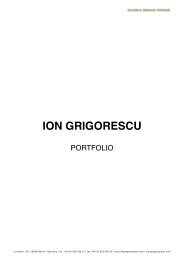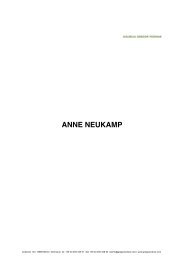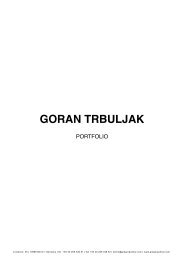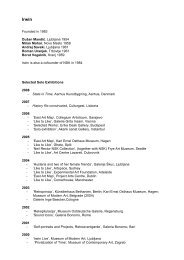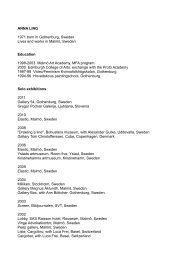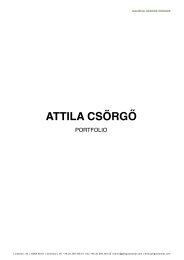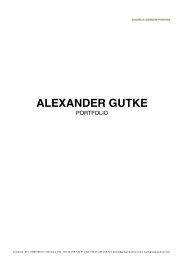interiores madrileños - Galerija Gregor Podnar.
interiores madrileños - Galerija Gregor Podnar.
interiores madrileños - Galerija Gregor Podnar.
You also want an ePaper? Increase the reach of your titles
YUMPU automatically turns print PDFs into web optimized ePapers that Google loves.
primož bizjak<br />
portfolio 2009
<strong>interiores</strong> <strong>madrileños</strong> 2007 - 2008
Esercizi di meditazione (Riccardo Caldura)<br />
… The City thus assumes the appearance of a chrysalis that is about to leave its<br />
cocoon, and the photographic image captures this delicate stage of metamorphosis between the ‘no longer<br />
the previous stage’ and the 'not yet' of the condition to come. The image prepares to grasp the point of<br />
transition between ruin and renewal, leaving to the things the time of their appearance, representing them at<br />
an hour that will be difficult for us to easily place in the usual course of the day. In Bizjak’s photographs, dusk<br />
seems to be confused with dawn, revealing the slow dream-like pulsation of the urban space. The length of<br />
the exposure of the photosensitive plate can be extremely long because the photographer/entomologist<br />
cannot predict when the chrysalis-city will unfold. He can only give free rein to the interaction, in a deserted<br />
scene, between two actors: light and things. Photography thus becomes the only means capable of recording<br />
an otherwise imperceptible happening. As in accurate focusing, the two stages of ruin and splendour become<br />
one. The past of the buildings, the traces of the earlier seasons in the city, its members scattered, dissected,<br />
and already partially recomposed, are illuminated by a light that - not by chance- recalls that of a Baroque<br />
painting. …
carcel de carabanchel, madrid 2008
karavle case di frontiera 2004.2006
The frontier guardhouses: the border between Slovenia and Italy<br />
It is the project about the ex-military border between Yugoslavia and Italy, established with Morgan’s<br />
agreement in 1947.<br />
Today, the area of ex-military border is abandoned. It is nobody’s land and has lost its original function. It is<br />
forgotten, because Europe which created it does not exist any more. So the military border is left not only to<br />
the nature but also to slowly and discreet new colonization of man and civil society.<br />
The work of Primož Bizjak is one of the most attentive and sensitive works that was made on the area of exmilitary<br />
border. Radical changes made in Europe are pointing out at specific architectures which hosted the<br />
frontier force of Yugoslavian Army. The history is made of details and it reflects itself in frontier<br />
guardhouses. It becomes micro-history, and the attentive photographer creates an extraordinary visual<br />
narration about what is happening with the military border that runs through the Alps, from the Italian-<br />
Austrian-Slovene triangle to the Adriatic coast, next to Trieste Gulf. This is a series of strictly defined<br />
photographs which were made by someone who has learned the lessons of minimalist and analytical<br />
contemporary photography, especially the one of Bernd and Hilla Becher. The series points out what has<br />
happened and what is still happening today with frontier guardhouses.<br />
The architectural module is always the same, as it was the part of the military system, and also the<br />
photographic analysis which documents the approximately 70 frontier guardhouses that existed on the<br />
border between Slovenia and Italy is always the same (the same viewpoint). On the other hand these same<br />
buildings appear to us always different, especially because the present buildings show very different states<br />
of preservation. Sometimes they are so devastated that all you can see are the remains of the walls. Bizjak<br />
does not select the buildings depending on its state or beauty. His repertoire is made of all frontier<br />
guardhouses, from first to the last, showing the actual situation of the “state border”: what remains when<br />
the motive for its existence is no longer present.
sarajevo in krajina 2004 .- 2006
venezia 2003 - 2005
For a photographer, Venice can be a trap or a springboard. It's easy to fall into the postcard photography,<br />
banality, into déjà vu. Therefore, Primož Bizjak has decided to discover and reveal to us, trough his night<br />
photography, another face of Venice, the face we do not know. It is not the Venice with its reflections in the<br />
water and neither Venice in the moonlight, but a city with its works in process, trash cans and channels in<br />
maintenance phase. This interpretation does not arise from a desire to be extravagant, but from a wish to<br />
exploit one of the characteristics which makes photography more penetrating in the dark than a human eye:<br />
the capacity to sum up the light during long expositions, registering onto the photo-sensible emulsion the<br />
forms and the colours which our sight does not percept or percepts in a different way. From here arises the joy<br />
and surprise of re-seeing and re-evaluating a view of the city which we otherwise overlook or discard because<br />
of its poor visual quality. In photographer’s work the system of vision, whose operating mode strongly<br />
influences photographer’s mental relationship to his object, plays a decisive role. The site is chosen with calm,<br />
the scene is studied and balanced without rush, the exposition is chosen and accomplished in most convenient<br />
time, sometimes even when natural and artificial light meet together. The execution time is slow, well-thought,<br />
and this is all reflected in a well-balanced photograph, in spite of disorder that it really represents. Colours are<br />
the result of Bizjak’s race with the night light, which is hidden and not perceived by human eye, but revealed<br />
on the film, which surprises us. This series of night photographs lacks the capacity of capturing the smell of<br />
dirty and stagnating water and the sound of water pumps: the scene is shown as poetic and aesthetic,<br />
transforming even s a trash can in a wonderful mess. And once more, we accept with pleasure the lies which<br />
photography presents.<br />
Guido Cecere
difesa di venezia 2009



